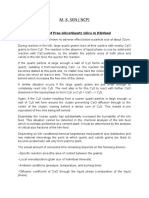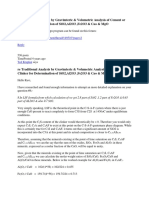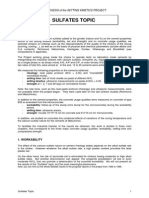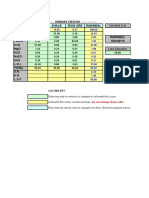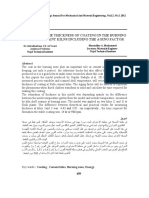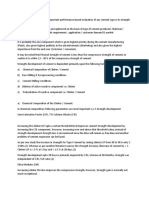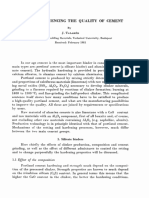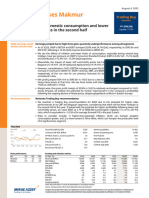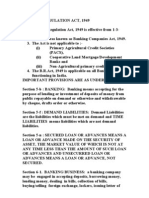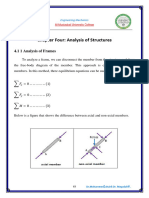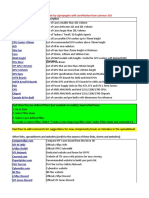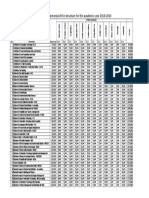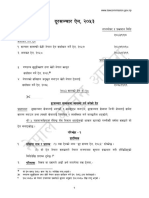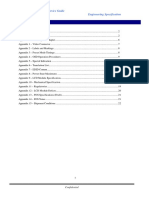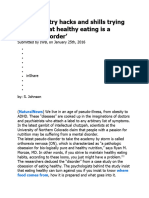Cement Kiln Process Chemistry: Module 2. Cement Clinker Quality and Composition
Cement Kiln Process Chemistry: Module 2. Cement Clinker Quality and Composition
Uploaded by
albertbunguriCopyright:
Available Formats
Cement Kiln Process Chemistry: Module 2. Cement Clinker Quality and Composition
Cement Kiln Process Chemistry: Module 2. Cement Clinker Quality and Composition
Uploaded by
albertbunguriOriginal Title
Copyright
Available Formats
Share this document
Did you find this document useful?
Is this content inappropriate?
Copyright:
Available Formats
Cement Kiln Process Chemistry: Module 2. Cement Clinker Quality and Composition
Cement Kiln Process Chemistry: Module 2. Cement Clinker Quality and Composition
Uploaded by
albertbunguriCopyright:
Available Formats
Cement Kiln Chemistry
2.1 Introduction
Cement Kiln Process Chemistry
Module 2. Cement Clinker Quality and Composition.
2.1
Introduction
In module 2 of the course we are going to focus on the quality and composition of cement
clinker. Perhaps we should first define quality as it relates to cement clinker.
Primarily clinker quality is judged
by the hydraulic performance of
cement made from the clinker.
Hydraulic performance of cement covers strength development, setting characteristics,
workability and durability and the consistency of those hydraulic performance
characteristics. The clinker quality and composition affects all these hydraulic
characteristics of the cement, although setting and workability can be adjusted or
controlled in the finish milling of the cement.
Durability of concrete made from cement is
certainly determined by the clinker quality and
composition. The clinker must be combined to a
low residual free lime (<2.5%) and not contain
more than 5% MgO. However, presuming
adequate combination, the strength development
of the cement made from the clinker is the
primary measure of clinker quality.
The strength development of cement, and
concrete made from cement, is determined by the
silicate content of the cement in the minerals C3S
and C2S. The higher the silica modulus (SM) of
clinker the greater the silicate content, but we
have seen in Module 1 that if the SM exceeds 4.0
then there are difficulties in combining the clinker.
The early strength of cement derives primarily from the C3S, the higher the lime
saturation (LSF) of the clinker the higher will be the C3S content, up to the maximum of
100% lime saturated.
Cement Kiln Chemistry
2.1 Introduction
The raw materials in kiln feed can be proportioned to high LSF and SM targets to
maximise silicate and C3S content, but what does lime saturation actually mean?
Will the real clinker mineralogy correspond with the target from the proportioning?
Will strength development of the C3S and C2S be as expected?
Is strength development only dependent on the amount of the C3S and C2S present?
Or is the C3S and C2S in some clinkers better at strength development than others?
What is the role of minor compounds and constituents in the clinker?
How can the strength development of the C3S and C2S be controlled and predicted?
These are the questions we will try to answer in this Module 2 of the course.
We will certainly not be able to answer these questions without an understanding of CaOSiO2-Al2O3-Fe2O3 (CSAF) quaternary system. The CaO-SiO2-Al2O3-Fe2O3 (CSAF)
quaternary system is where we will start in the next session of the course.
There is no exercise associated with this session 1 of module 2, however, I recommend
trying Quiz 2.1 to assess your current knowledge before studying the rest of the sessions,
then repeating later as self-assessment.
ii
You might also like
- Burning and Nodulization Process of Clinker in The Rotary Kiln As Viewed From The Fine Textures of The Constituent MineralsDocument6 pagesBurning and Nodulization Process of Clinker in The Rotary Kiln As Viewed From The Fine Textures of The Constituent MineralsAnonymous NxpnI6jCNo ratings yet
- Hand Book For Cement Engineers (Abdul Majid) PDFDocument247 pagesHand Book For Cement Engineers (Abdul Majid) PDFalbertbunguri50% (6)
- Bogue DeviationDocument8 pagesBogue DeviationElwathig BakhietNo ratings yet
- Cement Kiln Process Chemistry: Cemnet Training - Course Ckpc01 Module 2 - IntroductionDocument6 pagesCement Kiln Process Chemistry: Cemnet Training - Course Ckpc01 Module 2 - IntroductionElwathig BakhietNo ratings yet
- Effect of Free SilicaDocument2 pagesEffect of Free Silicamahendra senNo ratings yet
- Mineralisation PDFDocument11 pagesMineralisation PDFElwathig BakhietNo ratings yet
- 15 Quality Control Formulae: Rs 50 Proportioning of Raw MaterialsDocument2 pages15 Quality Control Formulae: Rs 50 Proportioning of Raw MaterialsDilnesa EjiguNo ratings yet
- TDCC Kiln Fuzzy ReportDocument11 pagesTDCC Kiln Fuzzy ReportbinhvtNo ratings yet
- Coating RingsDocument8 pagesCoating RingsIrshad HussainNo ratings yet
- Chapter 2. Portland CementDocument14 pagesChapter 2. Portland CementKhaled Al-SwairkiNo ratings yet
- What Is White Portland CementDocument3 pagesWhat Is White Portland CementOliver Raymundo100% (1)
- LSF CaculationDocument5 pagesLSF CaculationhamedNo ratings yet
- Sulfates Topic: Synthesis of The Setting Kinetics ProjectDocument10 pagesSulfates Topic: Synthesis of The Setting Kinetics ProjectcemsavantNo ratings yet
- Ultratech Report FinalDocument78 pagesUltratech Report FinalrahulNo ratings yet
- Everything You Need To Know About Cement Kiln Refractories - Infinity For Cement EquipmentDocument234 pagesEverything You Need To Know About Cement Kiln Refractories - Infinity For Cement EquipmentmasmsaNo ratings yet
- 01.02 Doctrine Raw MixDocument2 pages01.02 Doctrine Raw Mixrupesh soniNo ratings yet
- Calculation Material BalanceDocument11 pagesCalculation Material BalanceirfanNo ratings yet
- Main Burner: OperationDocument8 pagesMain Burner: OperationDIAGNENo ratings yet
- CementmaterilsDocument33 pagesCementmaterilsengineeringchemistry100% (1)
- Quality and Formulae 6Document1 pageQuality and Formulae 6zane truesdaleNo ratings yet
- Modelled Fate of Sulphur and Chlorine in Rotary Kilns Part I PDFDocument10 pagesModelled Fate of Sulphur and Chlorine in Rotary Kilns Part I PDFJohn GiannakopoulosNo ratings yet
- Dinesh Agrawal: Dry-ProcessDocument19 pagesDinesh Agrawal: Dry-ProcessSantanu PachhalNo ratings yet
- Cement Kiln Co-ProcessingDocument11 pagesCement Kiln Co-ProcessingflukemonsterNo ratings yet
- Free SilicaDocument1 pageFree Silicasrinivasu67No ratings yet
- PILLARD AKTUEL Progressive BurningDocument3 pagesPILLARD AKTUEL Progressive BurningSteveih100% (1)
- Rawmix DesignDocument2 pagesRawmix DesignBùi Hắc HảiNo ratings yet
- RedoxDocument7 pagesRedoxElwathig BakhietNo ratings yet
- Mineralogy of ClinkerDocument7 pagesMineralogy of ClinkerAyaz AhmadNo ratings yet
- Burning in A KilnDocument3 pagesBurning in A KilnNivedithaMuraliNo ratings yet
- Variation of Feed Chemical Composition and Its Effect On Clinker Formation PDFDocument7 pagesVariation of Feed Chemical Composition and Its Effect On Clinker Formation PDFs_prasy6540No ratings yet
- The 6 Main Process Fans in Cement FactoryDocument6 pagesThe 6 Main Process Fans in Cement Factorymahendra senNo ratings yet
- By Pass SystemDocument57 pagesBy Pass Systemsameh ibrahemNo ratings yet
- BIS - CementDocument12 pagesBIS - CementSuvendu DeyNo ratings yet
- The - 10 Basic Facts On ClinkerDocument1 pageThe - 10 Basic Facts On ClinkerParesh GohelNo ratings yet
- Optimization of Cement Manufacturing Process by Means of Clinker Micro StructureDocument12 pagesOptimization of Cement Manufacturing Process by Means of Clinker Micro StructureARNALDO BATTAGIN100% (3)
- International Cement Review, September 2002: Burning The MixDocument5 pagesInternational Cement Review, September 2002: Burning The MixarylananylaNo ratings yet
- Petroleum Coke Utilization For Cement Kiln FiringDocument8 pagesPetroleum Coke Utilization For Cement Kiln FiringSyeed SofieNo ratings yet
- Silo 9 Boulders Investigation ReportDocument20 pagesSilo 9 Boulders Investigation ReportWaka OngetiNo ratings yet
- Module 2 CSAF SystemDocument16 pagesModule 2 CSAF SystemElwathig BakhietNo ratings yet
- Chemical Composition & Effect ClinkerDocument8 pagesChemical Composition & Effect ClinkerSiddharth SinghNo ratings yet
- Loss On Ignition (L.O.I) : Concrete Technology (I) Lecture 3Document10 pagesLoss On Ignition (L.O.I) : Concrete Technology (I) Lecture 3Mahmoud HosnyNo ratings yet
- Department of Chemical EngineeringDocument19 pagesDepartment of Chemical EngineeringPandia RajanNo ratings yet
- Combustion Cement Kiln Exercise2.3.2Document2 pagesCombustion Cement Kiln Exercise2.3.2Mohammed AbdoNo ratings yet
- 1.1 Grinding Unit Optimization: Cemtech 2002 AthensDocument5 pages1.1 Grinding Unit Optimization: Cemtech 2002 AthensAhmad A. WahidurRijalNo ratings yet
- Specific Procedure For Lining Kiln Outlet - RK2Document7 pagesSpecific Procedure For Lining Kiln Outlet - RK2Waka OngetiNo ratings yet
- Estimation of The Coating in The Burning Zone PDFDocument19 pagesEstimation of The Coating in The Burning Zone PDFTOULASSI-ANANI Yves Lolo100% (1)
- Mid Term Report Kiln N CoalDocument32 pagesMid Term Report Kiln N CoalKailash NathNo ratings yet
- 7 Quality Management and Control of Cement Production - Ó+ Í - + - +ÝËÙ+ÏÍãDocument88 pages7 Quality Management and Control of Cement Production - Ó+ Í - + - +ÝËÙ+ÏÍãNova HeriNo ratings yet
- Combustion Interlocks and Process SafetiesDocument2 pagesCombustion Interlocks and Process SafetiesclauNo ratings yet
- Process Control of LURM MillDocument6 pagesProcess Control of LURM Millimam janiNo ratings yet
- FA Fineness - Comparing Residue On 45 and Blaine PDFDocument5 pagesFA Fineness - Comparing Residue On 45 and Blaine PDFTran Huynh NamNo ratings yet
- Infinity For Cement Equipment: Quality & Composition of Cement ClinkerDocument48 pagesInfinity For Cement Equipment: Quality & Composition of Cement ClinkerYhaneNo ratings yet
- Cement Kiln Process Chemistry: Cemnet Training - Course Ckpc01Document10 pagesCement Kiln Process Chemistry: Cemnet Training - Course Ckpc01Elwathig BakhietNo ratings yet
- Quality & Composition of Cement Clinker - INFINITY FOR CEMENT EQUIPMENT PDFDocument74 pagesQuality & Composition of Cement Clinker - INFINITY FOR CEMENT EQUIPMENT PDFSiddharth Singh100% (3)
- Cement Strength DevelopmentDocument6 pagesCement Strength DevelopmentMuhammadShoaib100% (1)
- Factor Affecting Cement StrengthDocument13 pagesFactor Affecting Cement StrengthGirma Tesema100% (1)
- Optimizing Cement Strength ZKG GermanyDocument5 pagesOptimizing Cement Strength ZKG GermanySarbaz BanozaiNo ratings yet
- Cement CompostionDocument22 pagesCement CompostionAlvin HaidarNo ratings yet
- Concrete As MaterialDocument3 pagesConcrete As MaterialAvijit PaulNo ratings yet
- Chemical, Cement, Clinker, Composition, Kiln, ConsumptionDocument6 pagesChemical, Cement, Clinker, Composition, Kiln, ConsumptionRetal MohamedNo ratings yet
- 3.1 Alternative MaterialsDocument4 pages3.1 Alternative MaterialsalbertbunguriNo ratings yet
- Environmental Monitoring Questionnaire (1/2) : Customer / ProjectDocument2 pagesEnvironmental Monitoring Questionnaire (1/2) : Customer / ProjectalbertbunguriNo ratings yet
- Kalpraxis Cement Plants PDFDocument14 pagesKalpraxis Cement Plants PDFalbertbunguriNo ratings yet
- Screw SamplerDocument2 pagesScrew SampleralbertbunguriNo ratings yet
- Air Slide Sampler: M&W Jawo HandlingDocument2 pagesAir Slide Sampler: M&W Jawo HandlingalbertbunguriNo ratings yet
- KHD SEPARATORS April 2012 PDFDocument4 pagesKHD SEPARATORS April 2012 PDFGilberto PérezNo ratings yet
- Kiln OperationDocument98 pagesKiln OperationMarvin Garcia Catungal84% (25)
- Kiln System Operations - by Gerald L Young and F. M.millerDocument44 pagesKiln System Operations - by Gerald L Young and F. M.millersadatjafari100% (2)
- Mirae Asset Sekuritas Indonesia INDF 2 Q23 Review A86140c7a2Document8 pagesMirae Asset Sekuritas Indonesia INDF 2 Q23 Review A86140c7a2Dhanny NuvriyantoNo ratings yet
- Stella McCartney 2Document28 pagesStella McCartney 2Simran PatelNo ratings yet
- Focus B1 Part 2 Unit StarterDocument4 pagesFocus B1 Part 2 Unit Starterkodi tvNo ratings yet
- Mark Meltons Geomorphology and Geography S Quantitative RevolutionDocument16 pagesMark Meltons Geomorphology and Geography S Quantitative RevolutionrelebohilemochesaneNo ratings yet
- MSS - CIVE2016 Structural Design 1Document8 pagesMSS - CIVE2016 Structural Design 1YashArnatNo ratings yet
- BR Act, 1949Document7 pagesBR Act, 1949aki16288No ratings yet
- Diarrhea Cmap ScriptDocument5 pagesDiarrhea Cmap ScriptmaryNo ratings yet
- MUCLecture 2024 224222Document9 pagesMUCLecture 2024 224222Dane Elaisa CalubaNo ratings yet
- Ann Masiker-Angel Virtues HAEAV-097 JoyDocument17 pagesAnn Masiker-Angel Virtues HAEAV-097 Joyvyarageorgieva1313No ratings yet
- Catalytic Chemistry in Industry: PremiseDocument36 pagesCatalytic Chemistry in Industry: Premisejai d gr8No ratings yet
- Seohyun & Yonghwa - Banmal SongDocument4 pagesSeohyun & Yonghwa - Banmal SongIngvar Estorco Jr67% (3)
- RunnTech W100 Series Thumbwheel ControllerDocument2 pagesRunnTech W100 Series Thumbwheel ControllerRunnTechNo ratings yet
- Keseluruhan Laporan: B & B LaundryDocument9 pagesKeseluruhan Laporan: B & B LaundrybaiqdevisandrianaNo ratings yet
- A IsDocument21 pagesA IsInnocent SnoozeNo ratings yet
- SFF PC Master ListDocument863 pagesSFF PC Master Listdimas70No ratings yet
- Audit Medis Dan Audit Klinis Di Rs 1515Document74 pagesAudit Medis Dan Audit Klinis Di Rs 1515Rosdiana HerminaNo ratings yet
- Fee Structure Suza 2018 2019Document1 pageFee Structure Suza 2018 2019RUBENI DAUDINo ratings yet
- Qatar Construction Sector: 1st Edition 2012Document92 pagesQatar Construction Sector: 1st Edition 2012syampkNo ratings yet
- Short Introduction To The Sony Vegas Movie StudioDocument15 pagesShort Introduction To The Sony Vegas Movie StudioAttila NagyNo ratings yet
- Buk 7275Document13 pagesBuk 7275Quiroz BradyNo ratings yet
- Empires Between Islam and Christianity, 1500-1800 Sanjay Subrahmanyam All Chapter Instant DownloadDocument33 pagesEmpires Between Islam and Christianity, 1500-1800 Sanjay Subrahmanyam All Chapter Instant Downloadlezqinyldrm100% (2)
- B2B Global Public Goods ChinDocument2 pagesB2B Global Public Goods ChinTiago GonçalvesNo ratings yet
- CutlassDocument4 pagesCutlasssinghajitbNo ratings yet
- HILUX Revo GD EwiringDocument14 pagesHILUX Revo GD EwiringRian KorchNo ratings yet
- दूर सञ्चार ऐन २०५३Document24 pagesदूर सञ्चार ऐन २०५३xekaficNo ratings yet
- Dell 2000FP LCD Monitor Service GuideDocument50 pagesDell 2000FP LCD Monitor Service GuideAndrew DclassifiedNo ratings yet
- Healthy Eating Is A Mental DisorderDocument3 pagesHealthy Eating Is A Mental DisorderRob BlaisNo ratings yet
- Peer Review Response SheetsDocument10 pagesPeer Review Response Sheetsapi-490405765No ratings yet
- Exercise 2: Venipuncture Using Vacuum Collection System: ObjectivesDocument28 pagesExercise 2: Venipuncture Using Vacuum Collection System: ObjectivesFrieda CayabyabNo ratings yet
- Heatventors IntroductionDocument7 pagesHeatventors IntroductionAbraham SehiNo ratings yet




